
DS18B20
.pdf
DS18B20
INITIALIZATION
All transactions on the 1-Wire bus begin with an initialization sequence. The initialization sequence consists of a reset pulse transmitted by the bus master followed by presence pulse(s) transmitted by the slave(s).
The presence pulse lets the bus master know that the DS18B20 is on the bus and is ready to operate. For more details, see the “1-Wire Signaling” section.
ROM FUNCTION COMMANDS
Once the bus master has detected a presence, it can issue one of the five ROM function commands. All ROM function commands are 8 bits long. A list of these commands follows (refer to flowchart in Figure 5):
Read ROM [33h]
This command allows the bus master to read the DS18B20’s 8-bit family code, unique 48-bit serial number, and 8-bit CRC. This command can only be used if there is a single DS18B20 on the bus. If more than one slave is present on the bus, a data collision will occur when all slaves try to transmit at the same time (open drain will produce a wired AND result).
Match ROM [55h]
The match ROM command, followed by a 64-bit ROM sequence, allows the bus master to address a specific DS18B20 on a multidrop bus. Only the DS18B20 that exactly matches the 64-bit ROM sequence will respond to the following memory function command. All slaves that do not match the 64-bit ROM sequence will wait for a reset pulse. This command can be used with a single or multiple devices on the bus.
Skip ROM [CCh]
This command can save time in a single drop bus system by allowing the bus master to access the memory functions without providing the 64-bit ROM code. If more than one slave is present on the bus and a Read command is issued following the Skip ROM command, data collision will occur on the bus as multiple slaves transmit simultaneously (open drain pulldowns will produce a wired AND result).
Search ROM [F0h]
When a system is initially brought up, the bus master might not know the number of devices on the 1-Wire bus or their 64-bit ROM codes. The search ROM command allows the bus master to use a process of elimination to identify the 64-bit ROM codes of all slave devices on the bus.
Alarm Search [ECh]
The flowchart of this command is identical to the Search ROM command. However, the DS18B20 will respond to this command only if an alarm condition has been encountered at the last temperature measurement. An alarm condition is defined as a temperature higher than TH or lower than TL. The alarm condition remains set as long as the DS18B20 is powered up, or until another temperature measurement reveals a non-alarming value. For alarming, the trigger values stored in EEPROM are taken into account. If an alarm condition exists and the TH or TL settings are changed, another temperature conversion should be done to validate any alarm conditions.
11 of 27

DS18B20
Example of a ROM Search
The ROM search process is the repetition of a simple three-step routine: read a bit, read the complement of the bit, then write the desired value of that bit. The bus master performs this simple, three-step routine on each bit of the ROM. After one complete pass, the bus master knows the contents of the ROM in one device. The remaining number of devices and their ROM codes may be identified by additional passes.
The following example of the ROM search process assumes four different devices are connected to the same 1-Wire bus. The ROM data of the four devices is as shown:
ROM1 00110101...
ROM2 10101010...
ROM3 11110101...
ROM4 00010001...
The search process is as follows:
1.The bus master begins the initialization sequence by issuing a reset pulse. The slave devices respond by issuing simultaneous presence pulses.
2.The bus master will then issue the Search ROM command on the 1-Wire bus.
3.The bus master reads a bit from the 1-Wire bus. Each device will respond by placing the value of the first bit of their respective ROM data onto the 1-Wire bus. ROM1 and ROM4 will place a 0 onto the 1-Wire bus, i.e., pull it low. ROM2 and ROM3 will place a 1 onto the 1-Wire bus by allowing the line to stay high. The result is the logical AND of all devices on the line, therefore the bus master sees a 0. The bus master reads another bit. Since the Search ROM data command is being executed, all of the devices on the 1-Wire bus respond to this second read by placing the complement of the first bit of their respective ROM data onto the 1-Wire bus. ROM1 and ROM4 will place a 1 onto the 1-Wire, allowing the line to stay high. ROM2 and ROM3 will place a 0 onto the 1-Wire, thus it will be pulled low. The bus master again observes a 0 for the complement of the first ROM data bit. The bus master has determined that there are some devices on the 1-Wire bus that have a 0 in the first position and others that have a 1.
The data obtained from the two reads of the three-step routine have the following interpretations:
00 There are still devices attached which have conflicting bits in this position. 01 All devices still coupled have a 0-bit in this bit position.
10All devices still coupled have a 1-bit in this bit position.
11There are no devices attached to the 1-Wire bus.
4.The bus master writes a 0. This deselects ROM2 and ROM3 for the remainder of this search pass, leaving only ROM1 and ROM4 connected to the 1-Wire bus.
5.The bus master performs two more reads and receives a 0-bit followed by a 1-bit. This indicates that all devices still coupled to the bus have 0s as their second ROM data bit.
6.The bus master then writes a 0 to keep both ROM1 and ROM4 coupled.
7.The bus master executes two reads and receives two 0-bits. This indicates that both 1-bits and 0-bits exist as the 3rd bit of the ROM data of the attached devices.
12 of 27

DS18B20
8.The bus master writes a 0-bit. This deselects ROM1, leaving ROM4 as the only device still connected.
9.The bus master reads the remainder of the ROM bits for ROM4 and continues to access the part if desired. This completes the first pass and uniquely identifies one part on the 1-Wire bus.
10.The bus master starts a new ROM search sequence by repeating steps 1 through 7.
11.The bus master writes a 1-bit. This decouples ROM4, leaving only ROM1 still coupled.
12.The bus master reads the remainder of the ROM bits for ROM1 and communicates to the underlying logic if desired. This completes the second ROM search pass, in which another of the ROMs was found.
13.The bus master starts a new ROM search by repeating steps 1 through 3.
14.The bus master writes a 1-bit. This deselects ROM1 and ROM4 for the remainder of this search pass, leaving only ROM2 and ROM3 coupled to the system.
15.The bus master executes two Read time slots and receives two 0s.
16.The bus master writes a 0-bit. This decouples ROM3 leaving only ROM2.
17.The bus master reads the remainder of the ROM bits for ROM2 and communicates to the underlying logic if desired. This completes the third ROM search pass, in which another of the ROMs was found.
18.The bus master starts a new ROM search by repeating steps 13 through 15.
19.The bus master writes a 1-bit. This decouples ROM2, leaving only ROM3.
20.The bus master reads the remainder of the ROM bits for ROM3 and communicates to the underlying logic if desired. This completes the fourth ROM search pass, in which another of the ROMs was found.
NOTE:
The bus master learns the unique ID number (ROM data pattern) of one 1-Wire device on each ROM Search operation. The time required to derive the part’s unique ROM code is:
960 s + (8 + 3 x 64) 61 s = 13.16 ms
The bus master is therefore capable of identifying 75 different 1-Wire devices per second.
I/O SIGNALING
The DS18B20 requires strict protocols to insure data integrity. The protocol consists of several types of signaling on one line: reset pulse, presence pulse, write 0, write 1, read 0, and read 1. All of these signals, with the exception of the presence pulse, are initiated by the bus master.
13 of 27

DS18B20
The initialization sequence required to begin any communication with the DS18B20 is shown in Figure 11. A reset pulse followed by a presence pulse indicates the DS18B20 is ready to send or receive data given the correct ROM command and memory function command.
The bus master transmits (TX) a reset pulse (a low signal for a minimum of 480 s). The bus master then releases the line and goes into a receive mode (RX). The 1-Wire bus is pulled to a high state via the 5k pullup resistor. After detecting the rising edge on the DQ pin, the DS18B20 waits 15-60 s and then transmits the presence pulse (a low signal for 60-240 s).
MEMORY COMMAND FUNCTIONS
The following command protocols are summarized in Table 4, and by the flowchart of Figure 10.
Write Scratchpad [4Eh]
This command writes to the scratchpad of the DS18B20, starting at the TH register. The next 3 bytes written will be saved in scratchpad memory at address locations 2 through 4. All 3 bytes must be written before a reset is issued.
Read Scratchpad [BEh]
This command reads the contents of the scratchpad. Reading will commence at byte 0 and will continue through the scratchpad until the ninth (byte 8, CRC) byte is read. If not all locations are to be read, the master may issue a reset to terminate reading at any time.
Copy Scratchpad [48h]
This command copies the scratchpad into the E2 memory of the DS18B20, storing the temperature trigger bytes in nonvolatile memory. If the bus master issues read time slots following this command, the DS18B20 will output 0 on the bus as long as it is busy copying the scratchpad to E2; it will return a 1 when the copy process is complete. If parasite-powered, the bus master has to enable a strong pullup for at least 10 ms immediately after issuing this command. The DS18B20 EEPROM is rated for a minimum of 50,000 writes and 10 years data retention at T=+55°C.
Convert T [44h]
This command begins a temperature conversion. No further data is required. The temperature conversion will be performed and then the DS18B20 will remain idle. If the bus master issues read time slots following this command, the DS18B20 will output 0 on the bus as long as it is busy making a temperature conversion; it will return a 1 when the temperature conversion is complete. If parasitepowered, the bus master has to enable a strong pullup for a period greater than tconv immediately after issuing this command.
Recall E2 [B8h]
This command recalls the temperature trigger values and configuration register stored in E2 to the scratchpad. This recall operation happens automatically upon power-up to the DS18B20 as well, so valid data is available in the scratchpad as soon as the device has power applied. With every read data time slot issued after this command has been sent, the device will output its temperature converter busy flag: 0=busy, 1=ready.
Read Power Supply [B4h]
With every read data time slot issued after this command has been sent to the DS18B20, the device will signal its power mode: 0=parasite power, 1=external power supply provided.
14 of 27
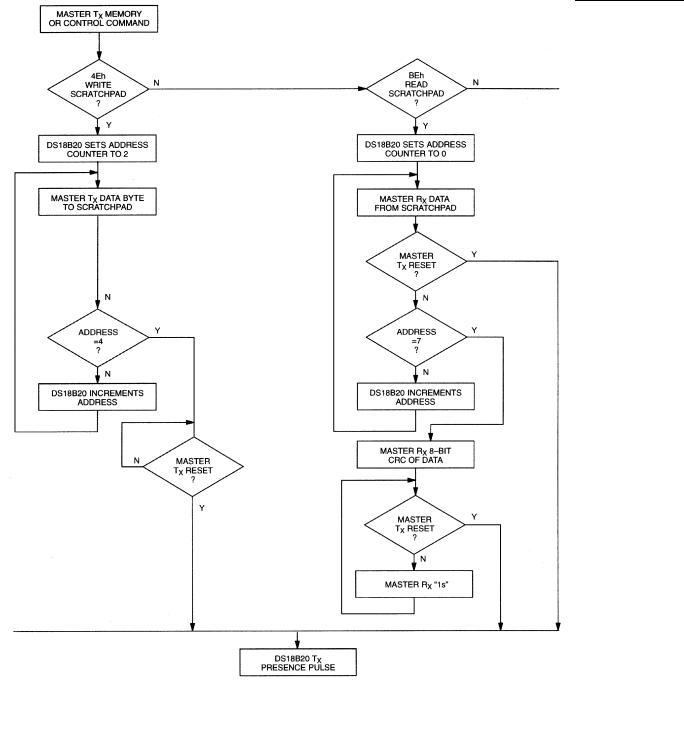
DS18B20
MEMORY FUNCTIONS FLOW CHART Figure 10
15 of 27
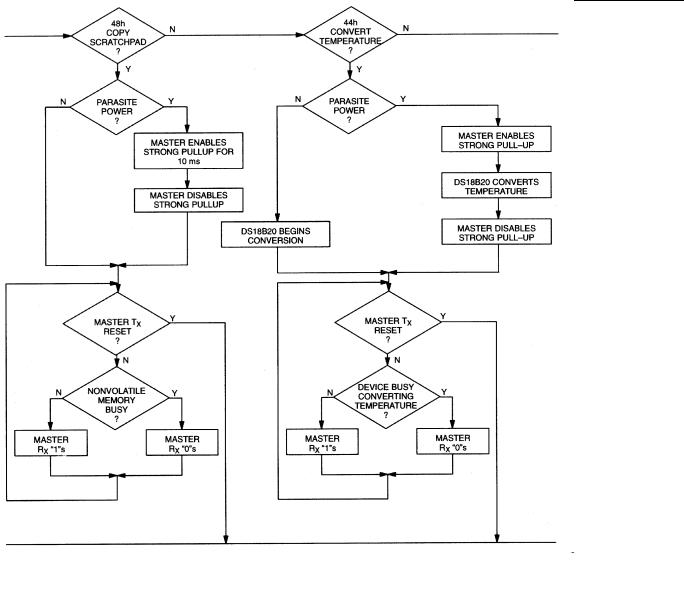
DS18B20
MEMORY FUNCTIONS FLOW CHART Figure 10 (cont’d)
16 of 27
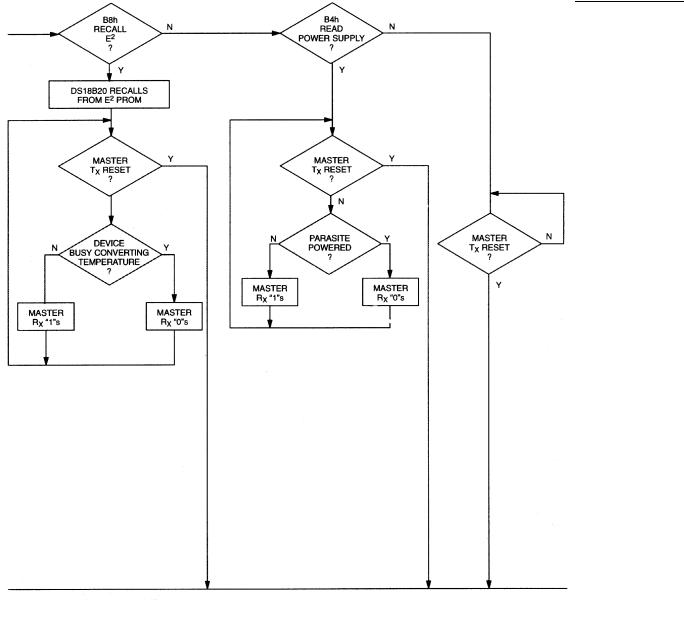
DS18B20
MEMORY FUNCTIONS FLOW CHART Figure 10 (cont’d)
17 of 27
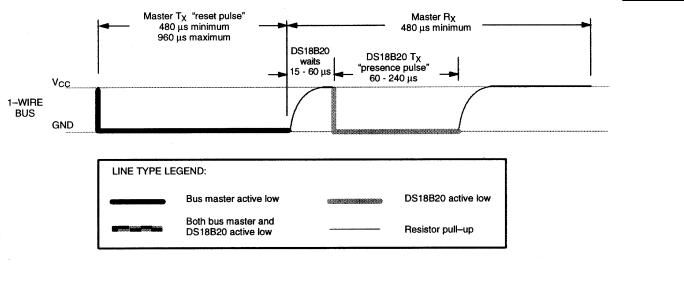
DS18B20
INITIALIZATION PROCEDURE “RESET AND PRESENCE PULSES” Figure 11
DS18B20 COMMAND SET Table 4
|
|
|
1-WIRE BUS |
|
|
|
|
AFTER ISSUING |
|
INSTRUCTION |
DESCRIPTION |
PROTOCOL |
PROTOCOL |
NOTES |
|
TEMPERATURE CONVERSION COMMANDS |
|
||
Convert T |
Initiates temperature |
44h |
<read temperature busy |
1 |
|
conversion. |
|
status> |
|
|
MEMORY COMMANDS |
|
|
|
Read Scratchpad |
Reads bytes from |
BEh |
<read data up to 9 bytes> |
|
|
scratchpad and reads |
|
|
|
|
CRC byte. |
|
|
|
Write Scratchpad |
Writes bytes into |
4Eh |
<write data into 3 bytes |
3 |
|
scratchpad at addresses 2 |
|
at addr. 2 through. 4> |
|
|
through 4 (TH and TL |
|
|
|
|
temperature triggers and |
|
|
|
|
config). |
|
|
|
Copy Scratchpad |
Copies scratchpad into |
48h |
<read copy status> |
2 |
|
nonvolatile memory |
|
|
|
|
(addresses 2 through 4 |
|
|
|
|
only). |
|
|
|
Recall E2 |
Recalls values stored in |
B8h |
<read temperature busy |
|
|
nonvolatile memory into |
|
status> |
|
|
scratchpad (temperature |
|
|
|
|
triggers). |
|
|
|
Read Power Supply |
Signals the mode of |
B4h |
<read supply status> |
|
|
DS18B20 power supply |
|
|
|
|
to the master. |
|
|
|
18 of 27

DS18B20
NOTES:
1.Temperature conversion takes up to 750 ms. After receiving the Convert T protocol, if the part does
not receive power from the VDD pin, the DQ line for the DS18B20 must be held high for at least a period greater than tconv to provide power during the conversion process. As such, no other activity may take place on the 1-Wire bus for at least this period after a Convert T command has been issued.
2.After receiving the Copy Scratchpad protocol, if the part does not receive power from the VDD pin, the DQ line for the DS18B20 must be held high for at least 10 ms to provide power during the copy process. As such, no other activity may take place on the 1-Wire bus for at least this period after a Copy Scratchpad command has been issued.
3.All 3 bytes must be written before a reset is issued.
READ/WRITE TIME SLOTS
DS18B20 data is read and written through the use of time slots to manipulate bits and a command word to specify the transaction.
Write Time Slots
A write time slot is initiated when the host pulls the data line from a high logic level to a low logic level. There are two types of write time slots: Write 1 time slots and Write 0 time slots. All write time slots must be a minimum of 60 s in duration with a minimum of a 1- s recovery time between individual write cycles.
The DS18B20 samples the DQ line in a window of 15 s to 60 s after the DQ line falls. If the line is high, a Write 1 occurs. If the line is low, a Write 0 occurs (see Figure 12).
For the host to generate a Write 1 time slot, the data line must be pulled to a logic low level and then released, allowing the data line to pull up to a high level within 15 s after the start of the write time slot.
For the host to generate a Write 0 time slot, the data line must be pulled to a logic low level and remain low for 60 s.
Read Time Slots
The host generates read time slots when data is to be read from the DS18B20. A read time slot is initiated when the host pulls the data line from a logic high level to logic low level. The data line must remain at a low logic level for a minimum of 1 s; output data from the DS18B20 is valid for 15 s after the falling edge of the read time slot. The host therefore must stop driving the DQ pin low in order to read its state 15 s from the start of the read slot (see Figure 12). By the end of the read time slot, the DQ pin will pull back high via the external pullup resistor. All read time slots must be a minimum of 60 s in duration with a minimum of a 1- s recovery time between individual read slots.
Figure 12 shows that the sum of TINIT, TRC, and TSAMPLE must be less than 15 s. Figure 14 shows that system timing margin is maximized by keeping TINIT and TRC as small as possible and by locating the
master sample time towards the end of the 15- s period.
19 of 27
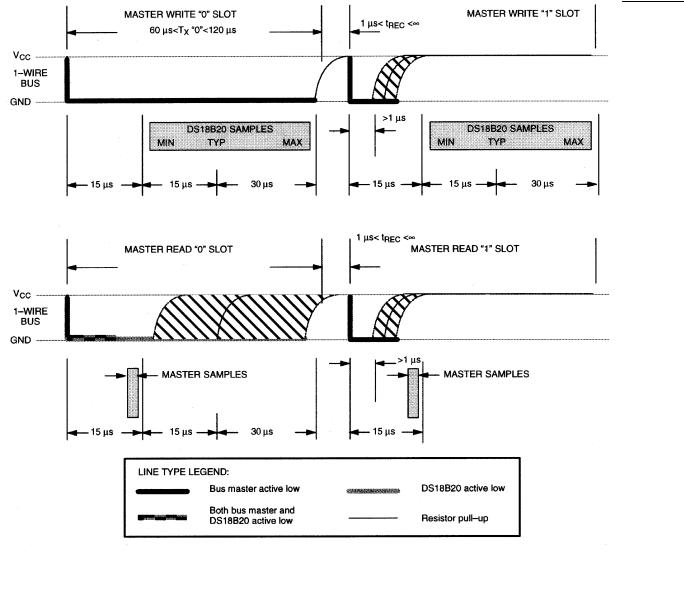
DS18B20
READ/WRITE TIMING DIAGRAM Figure 12
20 of 27
